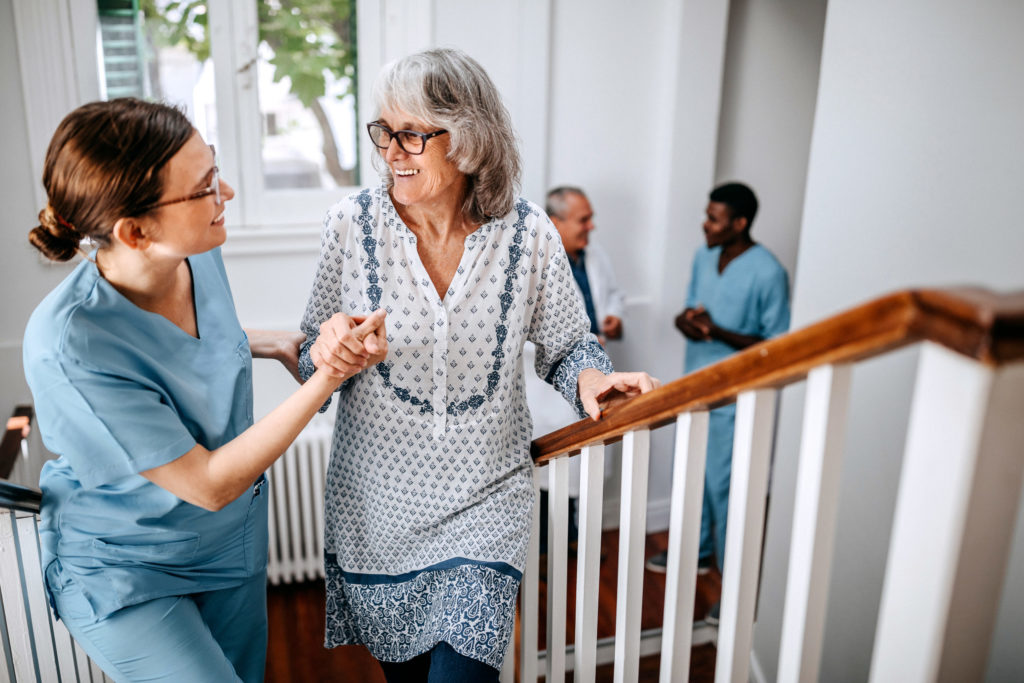There are plenty of resources out there for new parents to ‘baby-proof’ their homes. It’s a good idea to make everyone aware of potential safety hazards from the point-of-view of a newly-mobile toddler, from sharp corners on tables to dangerous chemicals within easy reach under the sink. This is the time when parents should consider investing in locks for cabinets and doors, putting up gates to block access to unsafe areas, and making sure other breakable items stay secure.
At the other end of the age spectrum, some caregivers and family members are also encouraged to look for ways to make their homes safer for seniors in their life.
This doesn’t mean that a senior should be treated in the same way as a baby. But it does mean that precautions should be taken for everyone’s safety. For the most part, except in advanced cases of dementia, seniors are aware of what they’re putting in their mouths and whether it’s good for them or not.
But they still would appreciate a living space that’s physically safe and secure.
For instance, someone who has mobility challenges may welcome more handholds or railings in hallways or on the stairs. Someone who uses a cane or a walker would also appreciate the removal of area rugs that could easily catch on the walker and cause them to slip and fall. The same could be true for looking for making slippery places less so.
A fall can be damaging for any age, but seniors are especially susceptible to suffering more severe injuries and they also can take longer to heal.
Bathrooms are also particularly concerning places: not only are there a lot of hard surfaces but the rooms can get slippery and more dangerous fast if there’s water, clothes, towels, or other obstacles on the floor. Showers and baths can create other hazards – they might be hard to get in and out of, requiring a lot of strength, balance, and flexibility, which could all be areas where some people might not be where they were in the past. A toilet can be raised or replaced so it’s easier to get up and down. Even hot water heaters can be lowered, or valves changed to reduce the risk of someone burning themselves with hot water.
A home evaluation can go a long way in pointing out suggestions for improvement and better safety conditions, such as handles in the bathtub to make entering and existing safe. A shower chair can allow someone to sit instead of stand, and no-slip stickers in the bathtub can also reduce danger.
Other rooms in the home can also receive the same evaluation.
Getting help
Caregivers and loved ones of seniors seeking this kind of support are in luck. Today, there are a variety of options available to provide safety guidance.
There are some private safety companies that can provide a walk-through of a home, pointing out potential hazards and making suggestions for any age.
In some cases, these services are included as part of occupational therapy.
While some may think of occupational therapy as a service that gets people back to work, such as after an accident or surgery, it also can benefit seniors and those with certain medical conditions who may have forgotten or lost the ability to perform certain tasks.
An occupational therapist can work with seniors to teach them to perform the skills they need to remain safe and live as independently as possible. This can include tasks like safely getting out of bed, grooming, and changing clothes in the morning, and doing the reverse when it’s time for bed.
Trained occupational therapists can also work with clients to make sure they’re able to successfully and safely navigate their home environment. This can include looking closely at where and how they perform their daily functions and what the environment is like, including getting from room to room or their regular daily routine.
An occupational therapist can determine if something they’re doing is unsafe, if there’s a safer way, or if there are any tools or other assistive devices available to make a task safer.
Learn more
Looking for ways to be safer in or around the home is a good idea any time of year but there is a greater push to do so at certain times of the year, and for any age.
The National Safety Council has declared June to be National Safety Month, an initiative that encourages people to be observant and focus on accident prevention anywhere, including work and home.
A similar initiative is National Safe at Home Week, which traditionally takes place the last week of August. This program encourages people to look at their homes to identify potential safety hazards for all ages, especially children. But some of the suggestions can be useful for all ages, including having an escape plan and watching for cords, which could be tripping or fire hazards.

